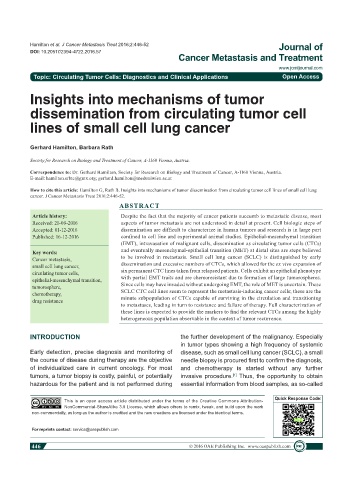Page 456 - Read Online
P. 456
Hamilton et al. J Cancer Metastasis Treat 2016;2:446-52 Journal of
DOI: 10.20517/2394-4722.2016.57
Cancer Metastasis and Treatment
www.jcmtjournal.com
Topic: Circulating Tumor Cells: Diagnostics and Clinical Applications Open Access
Insights into mechanisms of tumor
dissemination from circulating tumor cell
lines of small cell lung cancer
Gerhard Hamilton, Barbara Rath
Society for Research on Biology and Treatment of Cancer, A-1160 Vienna, Austria.
Correspondence to: Dr. Gerhard Hamilton, Society for Research on Biology and Treatment of Cancer, A-1160 Vienna, Austria.
E-mail: hamilton.srbtc@gmx.org; gerhard.hamilton@meduniwien.ac.at
How to cite this article: Hamilton G, Rath B. Insights into mechanisms of tumor dissemination from circulating tumor cell lines of small cell lung
cancer. J Cancer Metastasis Treat 2016;2:446-52.
ABSTRACT
Article history: Despite the fact that the majority of cancer patients succumb to metastatic disease, most
Received: 21-09-2016 aspects of tumor metastasis are not understood in detail at present. Cell biologic steps of
Accepted: 01-12-2016 dissemination are difficult to characterize in human tumors and research is in large part
Published: 16-12-2016 confined to cell line and experimental animal studies. Epithelial-mesenchymal transition
(EMT), intravasation of malignant cells, dissemination as circulating tumor cells (CTCs)
Key words: and eventually mesenchymal-epithelial transition (MET) at distal sites are steps believed
Cancer metastasis, to be involved in metastasis. Small cell lung cancer (SCLC) is distinguished by early
small cell lung cancer, dissemination and excessive numbers of CTCs, which allowed for the ex vivo expansion of
circulating tumor cells, six permanent CTC lines taken from relapsed patients. Cells exhibit an epithelial phenotype
epithelial-mesenchymal transition, with partial EMT traits and are chemoresistant due to formation of large tumorospheres.
tumorosphere, Since cells may have invaded without undergoing EMT, the role of MET is uncertain. These
chemotherapy, SCLC CTC cell lines seem to represent the metastasis-inducing cancer cells; these are the
drug resistance minute subpopulation of CTCs capable of surviving in the circulation and transitioning
to metastases, leading in turn to resistance and failure of therapy. Full characterization of
these lines is expected to provide the markers to find the relevant CTCs among the highly
heterogeneous population observable in the context of tumor recurrence.
INTRODUCTION the further development of the malignancy. Especially
in tumor types showing a high frequency of systemic
Early detection, precise diagnosis and monitoring of disease, such as small cell lung cancer (SCLC), a small
the course of disease during therapy are the objective needle biopsy is procured first to confirm the diagnosis,
of individualized care in current oncology. For most and chemotherapy is started without any further
tumors, a tumor biopsy is costly, painful, or potentially invasive procedure. Thus, the opportunity to obtain
[1]
hazardous for the patient and is not performed during essential information from blood samples, as so-called
Quick Response Code:
This is an open access article distributed under the terms of the Creative Commons Attribution-
NonCommercial-ShareAlike 3.0 License, which allows others to remix, tweak, and build upon the work
non-commercially, as long as the author is credited and the new creations are licensed under the identical terms.
For reprints contact: service@oaepublish.com
446 © 2016 OAE Publishing Inc. www.oaepublish.com

